Theory of computation miscellaneous
- The finite state machine described by the following state diagram with A as starting state, where
an arc label is x and x stands for 1-bit input and y stands for 2 bit output y 
-
View Hint View Answer Discuss in Forum
As per the given diagram.
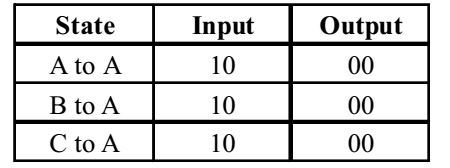
Therefore, the finite state machine outputs the sum of the present and previous bits of the input.Correct Option: A
As per the given diagram.

Therefore, the finite state machine outputs the sum of the present and previous bits of the input.
- Consider the NFA, M, shown below:
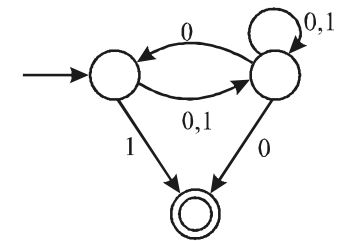
Let the language accepted by M be L. Let L1 be the language accepted by the NFA M1 obtained by changing the accepting state of M to a non-accepting state and by changing the non-accepting state of M to accepting states. Which of the following statements is true?
-
View Hint View Answer Discuss in Forum
The given machine M is
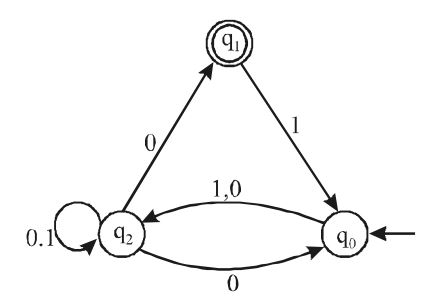
Now, the complementary machine M is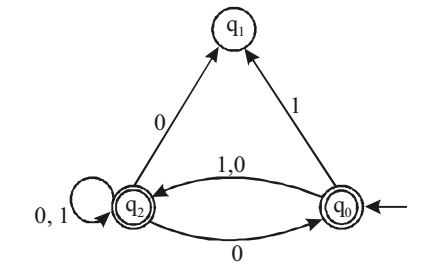
In the case of DFA, L(M) = L(M) but in the case of nfa this is not true. Infact L(M) and L (M) have no connection.
To find L1 = L(M), we have to look at M and directly find its language.
Clearly, λ = L(M), since q0 is accepting it (0 + 1) (0 + 1)* ∈ L(M), since q2 is accepting it.
∴ L(M) = L1 = l + (0 + 1) (0 + 1)*
∴ L1 = (0 + 1)* = {0, 1}*Correct Option: B
The given machine M is

Now, the complementary machine M is
In the case of DFA, L(M) = L(M) but in the case of nfa this is not true. Infact L(M) and L (M) have no connection.
To find L1 = L(M), we have to look at M and directly find its language.
Clearly, λ = L(M), since q0 is accepting it (0 + 1) (0 + 1)* ∈ L(M), since q2 is accepting it.
∴ L(M) = L1 = l + (0 + 1) (0 + 1)*
∴ L1 = (0 + 1)* = {0, 1}*
- Consider the following deterministic finite state automata M:
Let S denotes the set of seven bit binary strings in which the first, the fourth and the last bits are 1. The number of strings in S that are accepted by M is
-
View Hint View Answer Discuss in Forum
The strings accepted by the given automata are of type.
Option1 2 3 4 5 6 7 1 ― ― 1 ― ― 1
The four blank spaces can have a probability of having 0 or 1, so total 2(pow,4)= 16 strings are possible, but the given automata does not accept all of those.
1. 1 1 1 1 0 0 1
2. 1 1 0 1 0 0 1
3. 1 0 1 1 0 0 1
4. 1 0 0 1 0 0 1
5. 1 0 0 1 0 0 1
6. 1 0 0 1 1 0 1
7. 1 0 0 1 1 1 1
Hence (c) is correct optionCorrect Option: C
The strings accepted by the given automata are of type.
Option1 2 3 4 5 6 7 1 ― ― 1 ― ― 1
The four blank spaces can have a probability of having 0 or 1, so total 2(pow,4)= 16 strings are possible, but the given automata does not accept all of those.
1. 1 1 1 1 0 0 1
2. 1 1 0 1 0 0 1
3. 1 0 1 1 0 0 1
4. 1 0 0 1 0 0 1
5. 1 0 0 1 0 0 1
6. 1 0 0 1 1 0 1
7. 1 0 0 1 1 1 1
Hence (c) is correct option
- The regular expression 0* (10)* denotes the same set as
-
View Hint View Answer Discuss in Forum
Option (a) solves to (1*0*)1*
Option (b) solves to 0 + (0*1*0*)
Option (c) solves to 0*1*10(0*1*)
Therefore, none of the statement has the output equivalent to the given.Correct Option: D
Option (a) solves to (1*0*)1*
Option (b) solves to 0 + (0*1*0*)
Option (c) solves to 0*1*10(0*1*)
Therefore, none of the statement has the output equivalent to the given.
- The following finite state machine accepts all those binary strings in which the number of 1's and 0's are respectively.
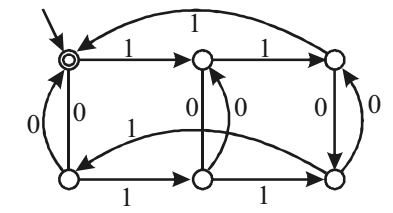
-
View Hint View Answer Discuss in Forum
The given finite state machine accepts any string W ∈ (0, 1)* in which the number of 1's is multiple of 3 and the number of 0's is multiple of 2.
Correct Option: A
The given finite state machine accepts any string W ∈ (0, 1)* in which the number of 1's is multiple of 3 and the number of 0's is multiple of 2.

